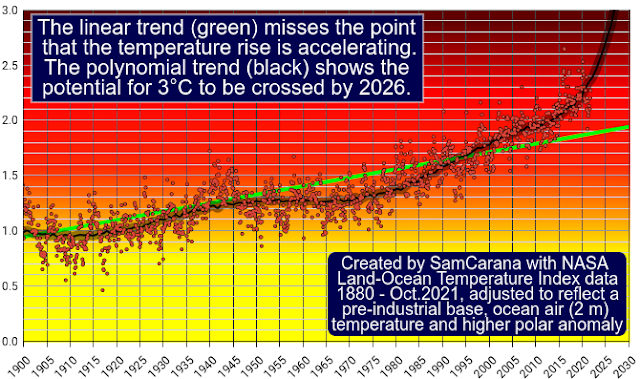by Malcolm Light
Below is Malcolm Light's Arctic methane growth diagram, updated in line with recent mean atmospheric methane concentrations and temperature data.
 |
| [ from earlier post ] |
NASA temperature data as adjusted by Sam Carana on the right show the potential for a mean temperature anomaly from pre-industrial of 3°C anomaly to occur late in 2022 (blue trend). By extension, a 4°C anomaly could occur in late 2023 and a 5°C anomaly in late 2024.
Above data was used to determine a trend line for exponentially increasing atmospheric methane increase, as well as where along the trend lines the surface atmospheric temperature anomalies would occur.
Above data was used to determine a trend line for exponentially increasing atmospheric methane increase, as well as where along the trend lines the surface atmospheric temperature anomalies would occur.
A surface atmospheric temperature anomaly of 10°C was recorded in France in the summer of 2020 (Copernicus 2020) with the overlying methane global veil giving a concentration of 2008 ppb. In this case the Global Warming is only partly caused by the methane (about 85.5%) and the rest by the concentration of other greenhouse gases.
It seems that we only have a very short time left until total Planetary Extinction due to the Arctic Atmospheric Methane Global Warming Veil. It is now clear that we do not have time to extract the methane from the subsea Arctic methane reserves, because we are so close to total extinction in 3 years.
Malcolm Light indicates three areas:
Area 1. Methane hydrates on the slope;
Area 2. Methane hydrates on the abyssal plane;
Area 3. Methane hydrates associated with the spreading Gakkel Ridge hydro-thermal activity (the Gakkel Riidge runs in between the northern tip of Greenland and the Laptev Sea).
In addition, huge amounts of methane are contained in sediments at the bottom of the shallow parts of the Arctic Ocean, in particular the East Siberian Arctic Shelf (ESAS). Dr. Natalia Shakova warned in 2008 that some 50Gt of carbon in the form of methane can be released at any moment from the East Siberian Arctic Shelf alone, because of the high temperature of the invading Atlantic (Gulf Stream) waters. This threatens to cause a 10°C surface atmospheric temperature increase leading to Global Extinction.
The cataclysmic weather events occurring worldwide including giant droughts and city-destroying fires, floods and summer and winter storm systems have already devastated Canada and the United States.
From the sharp increase in catastrophic weather events, it is obvious that ‘Mother Earth’ has correctly identified the North American continent as the source of its gigantic pollution problems. Extreme Fossil Fuel pollution from the United States and Canada has previously heated up the Gulf Stream which flows north into the Arctic Ocean as the Svalbard current, where it is now destabilizing the shelf methane hydrates in the Laptev Sea and on the East Siberian Arctic Shelf.
The image below illustrates that huge amounts of heat are entering the Arctic Ocean, driven by ocean currents and temperature differences.
 |
| [ from earlier post ] |
• NOAA - Trends in Atmospheric Methane
https://gml.noaa.gov/ccgg/trends_ch4/
• Human Extinction by 2022?
https://arctic-news.blogspot.com/2021/11/human-extinction-by-2022.html
• Arctic Ocean invaded by hot, salty water
• Anomalies of methane in the atmosphere over the East Siberian shelf: Is there any sign of methane leakage from shallow shelf hydrates? - by Shakhova, Semiletov, Salyuk and Kosmach (2008)
https://www.cosis.net/abstracts/EGU2008/01526/EGU2008-A-01526.pdf
• Will humans be extinct by 2026? - An exploration of the potential, by Sam Carana
• WARNING - Planetary Omnicide between 2023 and 2031 - by Malcolm Light
https://arctic-news.blogspot.com/2015/02/warning-planetary-omnicide-between-2023-and-2031.html
• Arctic Ocean invaded by hot, salty water
https://arctic-news.blogspot.com/2021/05/arctic-ocean-invaded-by-hot-salty-water.html
• Max, M.D. & Lowrie, A. 1993. Natural gas hydrates: Arctic and Nordic Sea potential. In: Vorren, T.O., Bergsager, E., Dahl-Stamnes, A., Holter, E., Johansen, B., Lie, E. & Lund, T.B. Arctic Geology and Petroleum Potential, Proceedings of the Norwegian Petroleum Society Conference, 15-17 August 1990, Tromso, Norway. Norwegian Petroleum Society (NPF), Special Publication 2 Elsevier, Amsterdam, 27-53.
https://www.elsevier.com/books/arctic-geology-and-petroleum-potential/vorren/978-0-444-88943-0
• Extinction by 2027- by Malcolm Light
https://arctic-news.blogspot.com/2021/05/extinction-by-2027.html
https://www.elsevier.com/books/arctic-geology-and-petroleum-potential/vorren/978-0-444-88943-0
https://arctic-news.blogspot.com/2021/05/extinction-by-2027.html
• Anomalies of methane in the atmosphere over the East Siberian shelf: Is there any sign of methane leakage from shallow shelf hydrates? - by Shakhova, Semiletov, Salyuk and Kosmach (2008)
https://www.cosis.net/abstracts/EGU2008/01526/EGU2008-A-01526.pdf
https://arctic-news.blogspot.com/2015/02/warning-planetary-omnicide-between-2023-and-2031.html


















